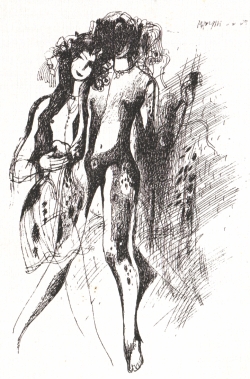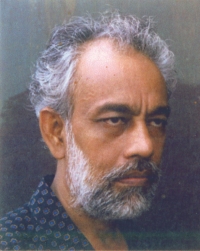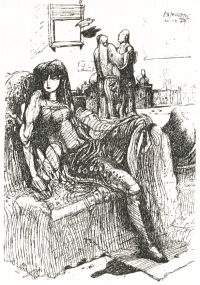| Home - Back Issues - The Team - Contact Us |
 |
| Volume 10 |Issue 36 | September 23, 2011 | |
|
|
Profile Mellow and Yet Outgoing Fayza Haq
With flowing white beard and snow-white hair, Chandra Shekhar Dey, who comes from Chittagong Art College, speaks about his work and ideas. This was over a delicious chicken roll, at the Bengal Gallery café, on a sunny afternoon. “Shekhar Da”, as he is known to many, who respect and admire him for his infinite knowledge of art and related subjects, has always had patience to discuss visual art. Mellow and yet outgoing, with time for nouveau concepts such as installations and video art, Shekhar is certainly “a man for all seasons”. Being with him is like a breath of fresh air. Gentle but outspoken, he does not mince his words. Poised and confident, after decades of teaching and guiding, his philosophy and ideas remain simple and easy to absorb. Speaking about why there is a wild rush towards abstraction across the world, the artists says that advertisements, electrical connections and media extensions like the mobile phones etc bring in a lifestyle so different from the one before. He says, "For better or for worse, the world has changed. Artists today watch many TV channels. They are just couch potatoes or lounge lizards. It is not easy to assimilate the flow of knowledge. There is confusion in the amassing of knowledge. The disciplined artist, however, does not jumble up his concept of lines and colours. He remains cool and confident in his selection of subjects and textures – as much as possible and probable." However, this is not easy. The artist says that one can get distracted and mesmerised by the political, economic and social matters that compound the life-style around him. It is difficult not to be overwhelmed by the turns and twists of happening around him. He says, "What happens in the US, the UK, Middle East, Tibet, India and China, with all the holocausts happing in the world — he can't remain totally impervious to them. An artist feels and thinks – as much as the next person. How can he not care about the global warming – when even the rickshaw-puller and the taxi-driver are speaking about it. The average man on the streets speaks about price hikes and bashing of automobiles – for apparently no rhyme or reason."
Each one is concerned about “roti, kapra aur makan”. It's impossible to live in an ivory tower these days. "In poetry, drama and fiction, today," says Shekhar, "There is the same mélange of confusion. It is the mirror of the state of affairs today, the world over. One second, one sees a billboard: and the next, one sees something else. It is a life of extreme competitions. The stress and mingling and mixing in our lifestyle are too much to bear for the average thinking person. The control is not at the hands of intellectuals but corporate demands. When the artist sits to paint, he is concerned about which gallery will sponsor him. The canvas, paint and brush prices have shot up. The artist has to survive and buy his materials. He can't remain in pervious to the reality around him. There is chaos all round the artist, and every creative person." How did leading icons, like Zainul Abedin. SM Sultan, Qamrul Hasan, paint in a manner that cannot be surpassed? Were there more inspiration, dedication and determination in artists of those days? What we see today is not so rich and amazing in style of subject matter, surely. Has there been anyone to equal or surpass them—surely not. Is it because the world has changed—and the artists are doing whatever best they can under the circumstances? Chandra Shekhar adds, “That group was undoubtedly talented and hard working. At that time the ground was created for the formation of Bangladesh. In 1952, the movement for a separate home for the Bengalis began. They revolted against Munaim Khan. At that time artists like Hashem Khan, Rafiqun Nabi, Monirul Islam, and Abu Taher worked for a separate homeland for the Bengali speaking people." Speaking of the background in which he had grown up, Shekhar speaks of the local signboard painter in Chittagong where he was born and spent the early part of his life. Ahmed Husain, he says, who painted cinema posters and billboards, and had had set up an art gallery there. In his childhood he saw a horse-drawn carriage around him. Hence, he says, he grew up in an area with urban characteristics. Poets and writers like Shamsur Rahman went to the gatherings that he visited.
At that time, during the Sixties, in the Pakistan days, the Beatles were popular. Bell-bottomed trousers were sported, he says. Just as today we tend to copy Mumbai, people in his youth copied the styles in Karachi, he says. The non-Bengalis, says Shekhar, who did business, mingled with the Bengalis with ease. “As I see it, there was no people to people problem. The division was a political one. The Bohras and Aga Khanis had friendly relationship with people like me. I believe that the politicians influence the people's mind. Even today there are bitter fights and division between the people of Bangladesh. This is done by politicians who have their own interests. The politicians have wanted to draw people to their ends through propaganda. Poets, artists and musicians want to live in their own peaceful world. We want to live in peace in our creative world – with nostalgia and dreams for the future. The violence in the name of democracy does not create harmony." He says that earlier there were “addas” at cafes. "This may not be today. However, some artists enjoy getting together in galleries to exchange ideas. Again, galleries promote young artists with talent. When artists like me came to Dhaka in the mid sixties, we found only one galley, 'Art ensemble', managed by artists Aminul Islam and Abu Taher, in a small building, near the BDR gate along the Dhanmondi Lake," he says, "A Pakistani lady had donated that building to the artists. Later on, there were art shops not galleries, like Saju's outlet at Gulshan today. These art shops collect the best paintings and have exhibitions. Galleries tend to sponsor artists with talent, and just not sell and frame paintings. ” The sense of values of the people of the 20th and 21st centuries seems to have changed so much that true art, with genuine soul-pitch and dedication cannot be easily dedicated as in the case of, centuries back, during the Renaissance painters of Italy and the great Dutch masters of the 14th and 15th centuries—with their inimitable colour combinations, play of light and shadow, and unique presentations of the human body and study of nature. Chandra Shekhar’s response to this is: "The artists at that time were thoroughly trained. They did not work from their memories. Their work was realistic and something the viewer was familiar with. The human beings and trees etc. were items in the paintings of Qamrul Hasan and Zainul Abedin. Visual beauty was of primary concern. These paintings were 'visual': So to put it. What came later was psychological. Art today reflects the struggles and strife of the artist more than being decoration items. If Zainul Abedin had been alive today, and man could live for a century, so to say, Zainul Abedin too would have painted differently. Time has changed man and his outlook. No man, if he is absolutely idealistic can survive in the present times. Man remains a product of his environment. Our singers, intellectuals, writers and artists must toe some line. He can't shut out his actual beliefs from housetops. Human beings today are controlled by factors beyond himself. The world remains complex and difficult to judge.”
Copyright
(R) thedailystar.net 2011 |


